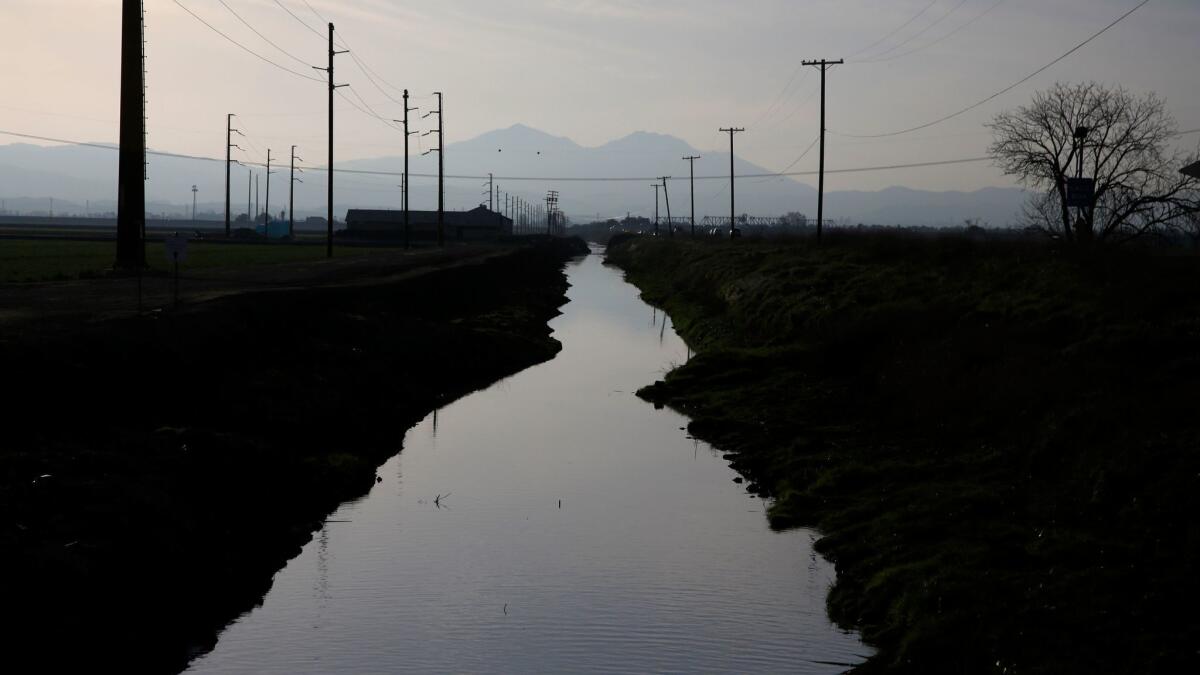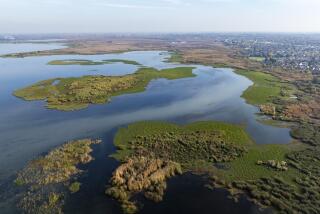Will the Southland wind up holding much of the $17-billion bill for the delta water tunnels?

Some of the state’s biggest water districts are about to make their opening moves in a financial chess game that ultimately could saddle the Southland with much of the bill for re-engineering the failing heart of California’s water system.
In coming weeks, the districts are expected to decide if they want to sign on to California WaterFix — a long-planned proposal to construct two massive tunnels that would change the way water supplies move through the Sacramento-San Joaquin Delta.
Backers long have operated under the assumption that the cost, now estimated at nearly $17 billion, would be split among customers of the big government water projects according to the size of their contracts for delta supplies.
Under that scenario, the largely urban agencies supplied by the State Water Project would pick up 55% of the tunnel tab, and the largely agricultural districts supplied by the federal Central Valley Project would pay for 45%.
But as the votes approach, there are growing doubts that agriculture will agree to pay that much.
“What happens if Central Valley farmers aren’t paying their share? Who’s going to get stuck with the costs?” said Mark Gold, who represents Los Angeles on the Metropolitan Water District of Southern California board. “That’s one of the big questions that’s out there. And to be honest, that’s not been very well-answered.”
The MWD is scheduled to vote Oct. 10 on a $4.3-billion tunnel buy-in. That amounts to 26% of the project, reflecting the district’s giant contract in the State Water Project.
As the biggest player, MWD’s support is vital. Other agencies with potentially large stakes in WaterFix are the Kern County Water Agency, a state contractor that serves irrigation districts in the southern San Joaquin Valley; the huge Westlands Water District, which gets delta supplies from the Central Valley Project; and the Santa Clara Valley Water District in the Bay Area.
“I think the level of participation is, if I had to guess, going to be different than 55-45. I don’t know how it’s going to play out,” said Curtis Creel, the Kern agency’s general manager.
“We think this is a good project. California needs to do this,” he said. “We also recognize that there may be folks out there that say, ‘I agree, but we simply can’t afford it, so we can’t participate.’ ”
Adding to the funding questions is the fact that two groups that by law get Central Valley Project water from the delta — wildlife refuges and irrigation districts with senior water rights — do not have to share the tunnel costs.
But even if tunnel backers, all of whom are due to vote this fall, don’t vote to fully fund the project, it won’t be the end of WaterFix. It will be the beginning of deal making.
MWD, for example, could enlarge its stake by buying or leasing part of another agency’s share. It then could keep the extra water for its own customers’ use or sell it in dry years to other districts.
“Kern and [MWD] are the people who really do well in a project like this because we have storage,” MWD General Manager Jeffrey Kightlinger said. His agency has a large Riverside County reservoir, and Kern County has several groundwater banks.
“If I got 40% of the benefits of this project, I would be more than happy to recommend to my board, let’s pay 40%,” Kightlinger said. “We’re the ones that can take and utilize that 40%…. Now, the board may disagree and say that’s too rich. That’s their option. But I’m not asking them to commit to that at the outset.”
Of course, a bigger investment would push up ratepayer costs.
A recent analysis by the Los Angeles Office of Public Accountability said WaterFix could add anywhere from $10.44 to $51.72 a year to the water bills of the city’s median single-family residence. The high number was partly based on the State Water Project paying for 68% of the project.
Another alternative would be to downsize WaterFix to match whatever water districts are willing to pay.
“You could potentially build a smaller system,” said Karla Nemeth, deputy secretary for water policy at the California Natural Resources Agency.
But after a decade of planning and multiple revisions to the current proposal, Kightlinger said he didn’t think there would be much interest in starting over.
He also said his board “has made it very clear” that it doesn’t want to strike any deal that would amount to a subsidy for farmers’ tunnel share.
Yet if the urban sector takes on a bigger portion of WaterFix, it is not clear how that could be avoided.
For one thing, the tunnels would be incorporated into the system that currently delivers water from the delta, making it difficult to ensure that agencies that don’t participate in the project don’t somehow benefit from it.
“There’s going to be fighting in the future forever between the parties that opted out and the parties that opted in over how much water the parties that opted out ought to get,” said Keith Lewinger, who represents the San Diego County Water Authority on the MWD board.
“I guarantee there will be litigation over that,” he said.
And if urban agencies sell tunnel water to irrigation districts during dry years, can — or will — it be priced to fully reflect the capital costs of the supplies?
Those who doubt agriculture’s willingness to pay its way got some ammunition in a report released this month by the U.S. Interior Department’s inspector general.
The office found that the U.S. Bureau of Reclamation, which oversees the Central Valley Project, improperly left federal taxpayers on the hook for $50 million in tunnel-planning costs that irrigation districts should have paid for.
Thanks to what the inspector general called a “complex, obscure process,” Central Valley Project contractors between 2009 and mid-2016 contributed only 18% of the more than $250 million in planning costs. State Water Project agencies, including MWD, contributed 47%.
Christopher Thornberg, a founding partner of Beacon Economics who has consulted for MWD on WaterFix, says growers can afford the tunnels. After all, he said, even during the recent drought, California agriculture enjoyed record revenues and high employment.
“Economically, it’s realistic. The farmers have as much to gain from these tunnels as anybody else,” he said. “Are they going to pay for it? Politically is it reasonable to assume that? The answer is almost assuredly ‘no.’
“They’re constantly crying poor, and they get away with it,” he said. “And my guess is … this will happen this time as well.”
Twitter: @boxall
More to Read
Start your day right
Sign up for Essential California for news, features and recommendations from the L.A. Times and beyond in your inbox six days a week.
You may occasionally receive promotional content from the Los Angeles Times.






